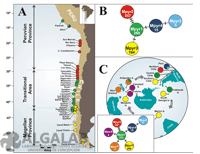
| Research | |||
Molecular methods have emerged as an important tool for taxonomy and sytematic. In macroalgae, DNA sequences such as COI (Cytochrome Oxidase c 1) have been recently used to identify several macroalgal organisms, specially when morphological features can not be used to discriminate species. Additional markers have been also used as "barcode" in macroalgae, such as: LSU D2/D3, rbcL-3P, tufA, ITS, UPA. In our lab we carrying out DNA barcode methods to identify representative macroalgal species from Bio Bio Region (central Chile). |
|||
We are also carrying out descriptive studies to know the effect of the last mega-earthquake (February 27/ 2010) and coastal uplift on macroalgal communities at Bio Bio region. On the right side you can see the uplifted kelp Lessonia nigrescens at Desembocadura del Bio Bio (August 2010). See also our photo gallery of algae after mega-earthquake. |
|||
In AlgaLAB we are carrying out several studies related with its distribution, abundance and ecology. |
|||
Once detached from substrata, some algae can remain floating at the sea surface and travel hundreds of kilometers. These algae have structures that provide buoyancy to lift blades toward the surface (the pneumatocysts). Previous studies have demonstrated that floating kelp rafts posses viable reproductive blades (e.g.Macaya et al. 2005, J Phycology 41:913-922). In AlgaeLAB we are studying the genetic structure of benthic and floating algae from Chilean Fjords in order to know the origin of floating kelp rafts but also the possible dispersal routes. |
|||
Chile offers an unique scenario to study algal phylogeography, different factors (biotic and abiotic – historic and contemporary) have shaped the distribution and genetic structure of macroalgae. For instance, Last glacial maximum, El Niño among others had an important effect on the genetic structure of kelp species (Macaya & Zuccarello 2010, MEPS 420:103-112). |
|||





